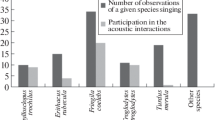Summary
In the species studied song appears to have two functions; an epigamic function = Display Song, and a contact function = Solitary Song. Solitary Song appears to be common to all the species studied. Its utterance indicates that the bird is unpaired or separated from another individual with which it has formed a bond. InUraeginthus bengalus, U. angolensis, andAmandava amandava Solitary Song is also uttered by the hen in similar circumstances. InLonchura punctulata, A. amandava, andEuodice malabarica song is usually but not completely inhibited by the presence of a mate, in whose absence Solitary Song will be uttered even when other individuals of the same species are present. In the species studied of the generaEstrilda, Lagonosticta, andUraeginthus Solitary Song is inhibited by the continued close proximity of another bird even though this may be of the same sex or of a different species and may elicit aggressive or fleeing reactions; but conditions of close association with a bird other than a suitable mate would presumably only occur under captive conditions. There appears to be a distance factor controlling such inhibition. There is evidence of the inhibition of song due to the presence of a mate in other passerine species.
Similar content being viewed by others
References
Andrews, R. J. (1961): The displays given by passerines in courtship and reproductive fighting. Ibis 103a, p. 549–579.
Delacour, J. (1943): A revision of the Subfamily Estrildinae of the Family Ploceidae. Zoologica 28, p. 69–86.
Harrison, C. J. O. (1956): Some Fire-Finches and their behaviour. Avic. Mag. 62, p. 128–141.
— (1962a): The affinites of the Red Avadavat,Amandava amandava. Bull. Brit. Orn. Club 81, p. 126–132.
— (1962b): An ethological comparison of some Waxbills (Estrildae) and its relevance to their taxonomy. Proc. Zool. Soc. Lond. 139, p. 261–282.
Moynihan, M. andHall, M. F. (1954): Hostile, sexual, and other social behaviour patterns of the Spice Finch (Lonchura punctulata) in captivity. Behaviour 7, p. 3–76.
Sharpe, R. B. (1890): Catalogue of the birds in the British Museum. Vol. 13, p. 403. London.
Steiner, H. (1960): Klassifikation der Prachtfinken, Spermestidae, auf Grund der Rachenzeichnungen ihrer Nestlinge. J. Orn. 101, p. 92–112.
Van Tyne, J. andBerger, R. J. (1959): Fundamentals of Ornithology. New York.
Wolters, H. E. (1957): Die Klassifikation der Webefinken (Estrildinae). Bonn. zool. Beitr. 8, p. 90–129.
Schrifttum
Lorenz, K. (1943): Die angeborenen Formen möglicher Erfahrung. Z. Tierpsych. 5, p. 235–409.
Schrifttum
Morris, D. (1958): The comparative ethology of Grassfinches (Erythrurae) and Mannikins (Amadinae). Proc. Zool. Soc. Lond. 131, p. 389–439.
Moynihan, M. andM. F. Hall (1954): Hostile, sexual, and other social behaviour patterns of the Spice Finch(Lonchura punctulata) in captivity. Behaviour 7, p. 33–76.
Schrifttum
Kunkel, P. (1959): Zum Verhalten einiger Prachtfinken (Estrildinae). Z. Tierpsych. 16, p. 302–350.
Rights and permissions
About this article
Cite this article
Harrison, C.J.O., Nicolai, J., Immelmann, K. et al. Solitary Song and its inhibition in some Estrildidae. J Ornithol 103, 369–379 (1962). https://doi.org/10.1007/BF01676599
Published:
Issue Date:
DOI: https://doi.org/10.1007/BF01676599




